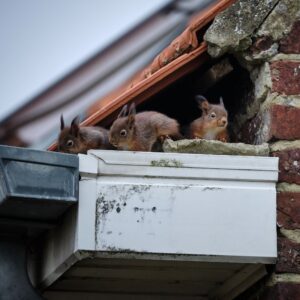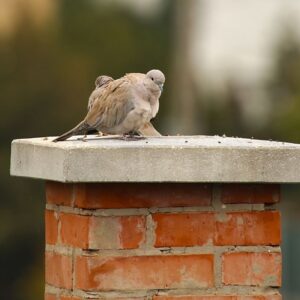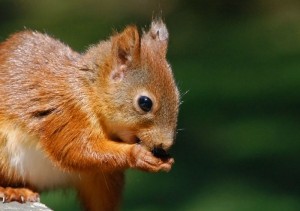URGENT!
Due to the weather, we are experiencing intermittent power outage and loss of internet. Please expect delays and or rescheduling of appointments during this time. We will reach out to you as soon as we can. Stay warm and stay safe!
Your cozy home and its inviting fireplace has the potential to attract unexpected guests – and we’re not talking about neighbors, in-laws, and your great-aunt Mildred. We’re talking about guests of the animal variety.
It’s not uncommon for animals to find their way into chimneys, seeking refuge from the elements or predators, or mistakenly stumbling upon what they perceive to be an ideal shelter. But once in your chimney, birds and mammals aren’t innocuous in their effects. How should you respond to an animal in your chimney system? And what preventative measures can you take to keep them out?
Here are some basics about what happens – and what action you should take – when animals find their way into your chimney. And if you have additional questions, be sure to reach out to see how we can help.
Some common chimney intruders include:
 Birds. Chimneys often resemble natural nesting spots for birds, providing elevation and shelter for their nests.
Birds. Chimneys often resemble natural nesting spots for birds, providing elevation and shelter for their nests.It may seem harmless to have an animal nesting in your chimney, especially if it isn’t during the burning season, but there are a number of issues that playing host to wildlife can present.
Animals can obstruct the chimney flue, either with their bodies or with debris they create or carry in, preventing proper ventilation. These blockages can increase the risk of harmful gases like carbon monoxide entering your living space. Blockages also become fire hazards, increasing the risk of a chimney or other uncontained fire.
Animals don’t also create blockages in your flue, they can also create damage in your chimney system. Gnawing, scratching, and nesting can cause structural damage to your chimney’s interior. And there are health risks associated with animal droppings, parasites, and diseases that some animals carry, as well as the unpleasantness of noises and odors animals can generate.
If you suspect – or have confirmed – that there’s an animal in your chimney, there are two calls you may need to make. If a live animal is trapped and in distress, you can call animal control or a licensed wildlife removal service. They’ll use their training to try to execute a humane removal with attention to safety. Keep in mind that animals that are afraid can act unpredictably, so keep children and pets out of the way.
Calling your chimney technician may also contribute to animal removal, as we have tools that help us access different areas of your chimney system. In prefabricated fireplaces, animals may find their way into areas outside the flue, which will require specialized removal techniques.
Abstain from using your heating appliance if you have an animal issue. While some homeowners think smoke will drive animals out, if the animal is trapped or can’t make its way out and dies, your problem is increased rather than solved!
It’s important to know that one creature that’s particularly partial to chimneys is the aptly named chimney swift, a gray, acrobatic, migratory bird that can’t perch. Instead, chimney swifts cling to vertical surfaces, using their saliva to create nests to adhere to places like the inside of your chimney flue. These birds are protected by the Federal Migratory Bird Treaty Act, and removing an active nest is punishable by jail time and/or substantial fines. If you have a family of chimney swifts, you’ll need to wait for removal until all young have left the nest.
In addition to helping remove the animal, your chimney sweep technician should be called upon to sweep and inspect a chimney that’s recently been infested. With the animal removed, sweeping the chimney will clear any leaves, twigs, droppings, feathers, or other debris from the nooks and crannies of your chimney system. This will help ensure that your system is unobstructed and ready for safe use again. If you notice odors coming from your chimney, the animal may have expired and animal removal, sweeping, and inspection is also needed.
 Another step to take once the animal is removed is asking your chimney professional about how to keep animals out in the future. This is one of those “an ounce of prevention is worth a pound of cure” cases.
Another step to take once the animal is removed is asking your chimney professional about how to keep animals out in the future. This is one of those “an ounce of prevention is worth a pound of cure” cases.
If you don’t have a chimney cap, or if it’s in disrepair, installing one will be an important first line of defense. A chimney cap sits on top of your flue, where it guards against anything entering your chimney. This won’t only help with animals, but other debris and precipitation that can be harmful for your system. The chimney cap covers the opening of your chimney exhaust while still allowing smoke and gases to vent.
Another helpful addition that may be recommended for your masonry fireplace chimney is a top-sealing damper, which helps control ventilation but would also aid in preventing animal intrusion by acting as a physical barrier. Finally, having your chimney inspected yearly will help identify and address potential entry points for wildlife and address them – as well as serving a number of other vital purposes.
While it’s disconcerting to realize an animal has made its way into your living space, don’t panic. We’re here to help, and to offer solutions to guard against recurrence. We’re in the business of helping you keep your chimney system running safely and optimally – and that includes wildlife staying in the wild and not in your chimney!
With some action steps and a little help from your friendly neighborhood pros here at Lords Chimney, you’ll be back to enjoying your fireplace soon. Call or reach out online now.
Spring has officially arrived, and with the warmer temperatures and longer days come new babies for many different kinds of animals. Unfortunately, many birds and small mammals may view your chimney as the perfect place to build a nest and raise their young. While many animals and their nests can be safely and humanely removed if they get into your chimney, one cannot: the chimney swift.
A chimney swift can be recognized by their size, color, movements, and sounds. Chimney swifts are small birds with narrow bodies and long wings. While up close they are a brown-gray color, they may appear black when backlit against the sky. Swifts fly and twist side to side erratically, and have a distinct high pitched chirp.
Although chimney swifts spend their winters in South America, they migrate north to the eastern United States and Canada each spring to nest and raise their young. According to the Cornell Lab of Ornithology, “Their ability to travel over long distances and through a variety of habitats exposes them to a wide range of microorganisms.”
Chimney swifts got their name because of their unique ability to build nests that stick to the side of slippery flue tiles. While swifts traditionally prefer to nest in hollow or dead trees, the increase in size of cities, suburbs, and agricultural areas has forced them to adapt.
If birds take up residence in your chimney, your first reaction may be to have them removed as soon as possible. Unfortunately for many homeowners, chimney swifts and several other species of migratory bird are protected under the Federal Migratory Birth Treaty Act. This law makes it illegal for anyone to remove or destroy chimney swift nests, eggs, or hatchlings, with severe fines and penalties for anyone who violates the law.
Luckily for those dealing with an unexpected nest of chimney swifts, the birds have a relatively short nesting period. Chimney swifts can lay, hatch, and raise their young in about six weeks. Likewise, as they nest in the spring and summer when fireplaces are not typically in use, the presence of a chimney swift nest of often little more than a minor inconvenience.
Because chimney swifts cannot be removed once they have taken up residence in your chimney, the best thing homeowners can do to prevent them is to have their chimney regularly inspected. A chimney inspection can ensure that there are no areas for chimney swifts to enter through, such as a damaged chimney cap.
Likewise, because chimney swifts are migratory they tend to return to the same nesting ground each year. Because of this, if you have chimney swifts find their way into your chimney it is extremely important to have the chimney inspected and repaired after they leave. If not, you may find that your chimney becomes an annual summer home for a family of chimney swifts.
If you think you have birds in your chimney, contact Lord’s Chimney today. Our expert technicians will be able to find out if they can be removed as well as help prevent them from getting in again.
A fireplace can be a wonderful addition to any room in the house where the family might gather, providing warmth, light, and a cozy ambiance. However, a fireplace system has to be carefully maintained to make sure that they common problems that affect chimneys don’t impact the safety and beauty of your family’s favorite gathering spot. We as homeowners owe it to ourselves to remain constantly vigilant as far as the condition of any part of our homes are concerned. Like every appliance or piece of furniture we own, a chimney requires just as much attention; one could even argue that it requires more attention.
Creosote, the byproduct of burning wood, builds up on the sides of the flue system and the firebox area. Over time, this buildup can cause blockages that result in flue fires or potentially a whole-house fire. A buildup of as little as 1/8 – 1/4” is more than enough to create a fire hazard. Regular cleaning eliminates the chance for creosote to develop on chimney surfaces.

This little critter is just one of the many things that could potentially block your chimney. Call the experts to have your chimneys cleared.
Birds, squirrels, or raccoons, among other animals, get in the chimney and cause issues inside that include smells, noises, blockage, and even fires. In addition to these concerns, the animals themselves may clog the chimney and, in some cases, could even carry diseases that could spread into your home. Chimney caps with spark arrestors are a common means to prevent animals from entering the space and nesting.
Because of the location of your chimney, leaves and debris can build up in and around the chimney year round. These things can clog the chimney, which is far more dangerous than it sounds. If the chimney is clogged, it will keep smoke and combustible gases in the home rather than letting them out. This can lead to any number of health risks as well as an increased risk of fire.
While the firebox of the fireplace system can be easily seen and therefore monitored by the homeowner, the chimney itself commonly faces a number of troubles that are often caught only by a chimney professional. Your annual chimney inspection, sweeping and cleaning will help to ensure its safety and continued functionality for years to come. You can always come to Lords Chimney with any of your questions or needs. Our staff is always here to help.